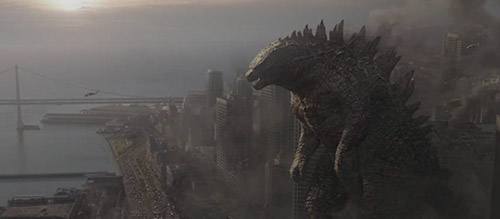Godzilla (2014) Review
This article was originally published to SSP Thinks Film by Sam Sewell-Peterson.
Godzilla (2014)
Director: Gareth Edwards
Screenwriters: Max Borenstein, Dave Callaham
Starring: Aaron Taylor-Johnson, Elizabeth Olsen, Bryan Cranston, Ken Watanabe, Sally Hawkins, Juliette Binoche, David Strathairn, Carson Bolde, CJ Adams
67 years ago, Japanese studio Toho burst onto the international stage with Godzilla, an astonishing sci-fi/fantasy allegory for the Japanese nightmares of Hiroshima and Nagasaki. In 2014, a new vision of this well-worn story emerged from Monsters and Rogue One director Gareth Edwards.
The film opens in 1999 with two scientists (Ken Watanabe and Sally Hawkins) investigating the accidental excavation of some colossal animal remains in the Philippines. Along with a reptilian skeleton the size of a skyscraper, they discover something has hatched from a pair of strange eggs and is heading straight for the Japanese mainland. On the outskirts of Tokyo, nuclear physicist Joe Brody (Bryan Cranston) discovers some seismic anomalies and advises the immediate evacuation of the plant he oversees, but not in time to save everyone he loves. Cut to years later, and driven by his guilt and obsessive searching for answers, Joe and his estranged Naval officer son Ford (Aaron Taylor-Johnson) get caught up the chaos and destruction of monsters new and old making their presence known to the world.
While Edwards’ Godzilla pays tribute to Ishiro Honda’s original film quite explicitly at times – a monorail train comes off quite badly after crossing paths with a monster, Watanabe shares a name with a key character from the earlier film – the real lifeblood of Godzilla 2014 owes a debt not so much to Honda, but to Steven Spielberg and Jurassic Park. There are an obscene amount of references to the classic dino-disaster in terms of the story’s shape, the look and tone of the film at large, and even specific individual shots. The Jurassic Park nods include, but are not limited to: a creature imprisoned in a cage of electrified wire pinging the wire with a claw as it escapes; a comic moment where a bus driver has to wipe away fog from his windscreen to adequately survey the carnage going on outside his vehicle; Godzilla striking a victory pose and roaring triumphantly after a particularly tough fight. There’s also a clear nod to Edwards’ own debut film, and possibly even a reference to Roland Emmerich’s much-maligned 1998 Godzilla remake.
Whereas Honda’s Godzilla had nuance, depth and something important to say, Edwards’ film feels annoyingly non-committal. It never dares to make the leap to blame any one source for the events of the film. The Toho Godzilla was unashamedly an anti-nuclear, and anti-war piece, but this movie can’t seem to decide whether nuclear power, the destruction of nature, pollution, mankind’s violent nature or all of the above are to blame. By being non-committal it ends up criticising nobody – it’s all just a bit wishy-washy and lacking much-needed punch in the script.
Godzilla’s adversaries in the film, the radiation-sustained monsters dubbed “MUTOs”, are really dull in their inception, like a lazy amalgamation of the arachnids from Starship Troopers and the creature from Cloverfield. They inspire a newfound appreciation of how much effort and creativity went into designing the vibrant and varied kaiju of Pacific Rim.
Aaron Taylor-Johnson’s Ford makes for a serviceable but vanilla hero. His motivations – the protection of his young family (Elizabeth Olsen and Carson Bolde), and a general sense of duty – make sense, but the macho-reckless way he goes about fulfilling them defies logic, and undermines his character. It could have been really interesting having a young military father torn between his paternal instincts and his patriotic drive, but instead, half the time Ford seems to forget he has a family. The more talented cast members are either under-used (Cranston) or are good, but not good enough to hold up an entire film (Watanable, Hawkins).
Alexandre Desplat’s score for the movie is admittedly gorgeous, a bright spot in a world of grey and brown. It is grand and rich, and sits perfectly between East and West orchestration styles, with cues echoing the original film’s iconic score.
The H.A.L.O jump set-piece that was splashed all over the marketing is a very impressively constructed sequence, a painterly image designed for cinema posters. Sadly it doesn’t last much longer than it did in the film’s trailer however, and no other action beat in the film comes close to matching it.
The idea that Godzilla essentially functions as nature’s factory reset button is cleverly presented, but the big scaly dude himself is hardly ever there. When he’s on-screen, either standing proud against devastated cityscapes, or swimming crocodile-like between aircraft carriers with his towering spines exposed, or unleashing his secret weapon to turn the tide of battle – he’s wonderfully realised, but fans won’t feel like they’ve really got their Godzilla fix, or, as strange as it sounds, won’t feel like they got to know him, which isn’t good in a film about (and titled after) Godzilla.
Gareth Edwards’ take on Godzilla had a lot of potential – a solid cast, an interesting up-and-coming director and a studio already well-versed in giant monster carnage. But Edwards may have bitten off more than he could chew by going straight from independent creature sleeper hit to helming the latest revival of one of the biggest icons in creature feature history. If only the script, the performances and the characters had been as impactful as the soundtrack and visuals.
10/24
Recommended for you: Showa Era Godzilla Movies Ranked (1954-1975)


